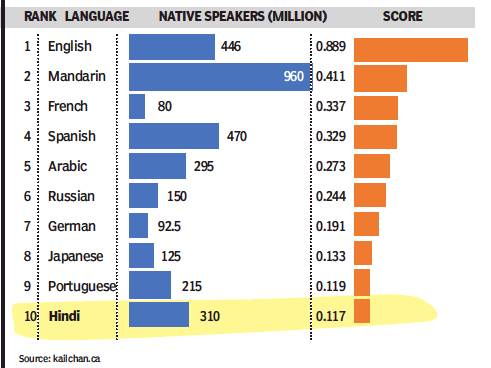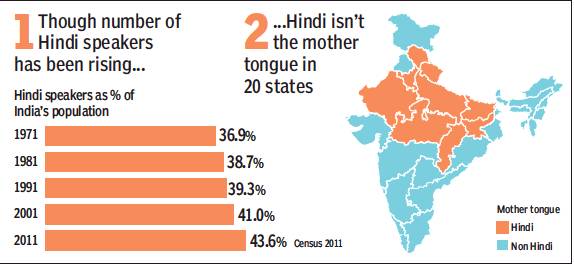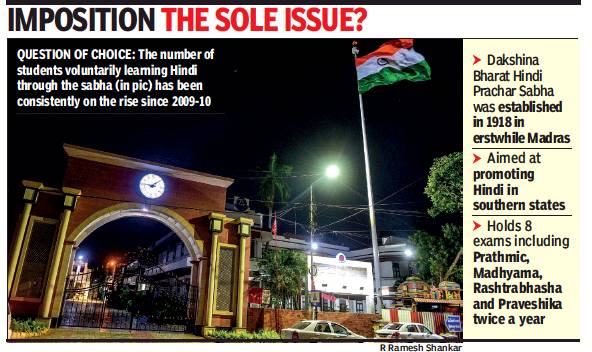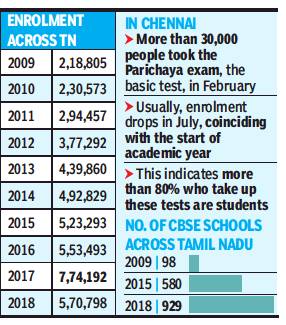Hindi language, the spread of
This is a collection of articles archived for the excellence of their content. |
Contents |
Global power
No. 10 in 2018
December 2, 2018: The Times of India

From: December 2, 2018: The Times of India
7,000 Estimated number of captive tigers — pets and zoo animals — in the US. It’s roughly double the world’s wild tiger population
English is world’s most powerful language, movies help Hindi finish at 10th place
How do we decide which is the world’s most powerful language? Should we go by the number of native speakers, or a language’s role in the global economy? Why not consider the geographical area over which a language is spoken, or its usefulness in diplomacy? But none of these parameters is enough by itself. So, Kai L Chan, a distinguished fellow at the French business school Insead, has developed a ‘Power Language Index’ that weighs each language’s influence over geography, economy, communication, knowledge & media, and diplomacy.
All things considered, English finishes first with a weighted score of 0.889 (out of 1), topping all five categories even though it has the third highest number of native speakers. Mandarin is a distant second. Hindi finishes 10th overall, but is second in the ‘knowledge & media’ category because of the large number of Hindi films made.
The population that speaks Hindi
1971-2011

From: Manash Gohain, June 4, 2019: The Times of India
See graphic:
Hindi speakers as % of India's population, 1971-2011
Status in India, state-wise
Tamil Nadu
2001-11, increase in speakers: South: 13%; TN: 50%; decline among Kannadigas
Tamil Nadu, which has long opposed the “imposition” of Hindi in the state, saw a rise of 50% Hindi speaker among Tamilians between 2001 and 2011, according to the latest census data. Overall, the percentage of Hindispeaking south Indians, however, rose by only 13% during the same period, and even declined among Kannadigas.
The anti-Hindi agitation of the 1960s led to several generations of Tamilians not learning the language. Things have changed with large scale migration of people from India’s north, north-east and northwest as blue collar and white collar workers.
“The absolute number of Tamilians speaking Hindi might be small. But given the current preference for CBSE and ICSE schools, more students could be opting for Hindi as second and third language. Also those looking for jobs outside Tamil Nadu may be learning Hindi,” said international population expert P Arokiasamy.
“There are several reasons for Tamilians learning Hindi. Migration is one, but TV programmes also influence Tamil people. The shift started when the Ramayana and the Mahabharata were telecast,” said sociologist G S Karanth.
All Tamilians speaking Hindi are not conversant with the language; many mix a bit of Tamil, English and Hindi and are able to convey what they want to say. “An autorickshaw driver may not be a Hindi pundit but if he can convey to his passenger in broken Hindi the charge for the ride, the route etc., the work is done. Thus learning Hindi also means increasing a person’s income in changed circumstances,” said Karanth. “Many company bosses are from the north and they only speak Hindi. Unless you learn Hindi, it will be difficult to work under them,” he said.
2016
See graphic:
Hindi in TN in 2016
2009-18: no. of students learning Hindi rises
Ram Sundaram, June 9, 2019: The Times of India

From: Ram Sundaram, June 9, 2019: The Times of India

From: Ram Sundaram, June 9, 2019: The Times of India
No. of students learning Hindi in TN rising as CBSE schools mushroom
Parents Feel Tamil And English Aren’t Enough, Want Better Career Opportunities For Kids
The three-language formula included in the draft new national education policy may have raised the hackles of politicians in Tamil Nadu, but the number of people learning Hindi in the state has been steadily increasing, particularly with the mushrooming of CBSE-affiliated schools, suggesting that the problem is not with learning the language but in forcing it on students.
The number of students voluntarily learning Hindi through the Dakshina Bharat Hindi Prachar Sabha, launched in 1918 to promote the laguage in the south, has been consistently on the rise since 2009-10 when Samacheer Kalvi (uniform state syllabus) was made mandatory and CBSE schools began flourishing because of the better syllabus. From just 98 schools 10 years ago, there are now more that 950 institutions permanently affiliated to the Central Board of Secondary Education (CBSE) in the state and a thousand others with temporary affiliation. In the same period, the number of candidates appearing for exams conducted by the Sabha rose from two lakh to 5.7 lakh, 80% of them school students, says official data. No other southern state has recorded such a growth. In Chennai, those with Hindi in the school syllabus are more keen on learning the language through these exams, said S Jeyaraj, general secretary of the Sabha. Parichaya, the preliminary test, is conducted twice every year.
While more than 30,000 appear in February, less than 10,000 take it up in July, because many don’t want to appear for such exams at the start of an academic year. “This also suggests that parents want their children to learn Hindi as a language as they feel English and Tamil alone are not enough and people in Tamil Nadu don't hate Hindi as a language as such,” he added.
Dravidar Viduthalai Kazhagam leader Kolathur Mani agrees, saying Periyar or his followers never asked people not to learn Hindi. They opposed it only when it is was sought to be made compulsory in schools. “Many would have started learning Hindi because of the job opportunities associated with it, particularly teachers. Also, a majority of those who studied Hindi through these exams would be from forward communities and not from remaining sections of society.”
P Kannan, whose son studies in a CBSE school, said he didn’t want the boy to face the embarrassment he did when he travelled to other states for work. “It is always better to know more languages as it increases his chance of employment.”
World Hindi Conference
August 18, 2018: The New Indian Express
Dipanjan Roy Chaudhury, August 18, 2018: The Economic Times
World Hindi Conference was started in 1975 to make the Hindi language a medium of service and knowledge and enable it to move forward with the time. Since then, Hindi has made remarkable progress and it has become one of the prominent languages of the world. (ANI) It is held every three years.
The logo of the conference presents the image of a ship struggling to keep sailing in the water is similar to what the difficulties Hindi is facing today.
The 11th World Hindi Conference, 2018/ held in Mauritius
August 18, 2018: The New Indian Express
The delegates from India and various countries of the world will deliberate on eight subtopics on Hindi World and Indian Culture during the three-day conference. This year the theme of the conference is "Hindi World and Indian Culture".
See also
Central Board of Secondary Education (CBSE)
Hindi language, the spread of
